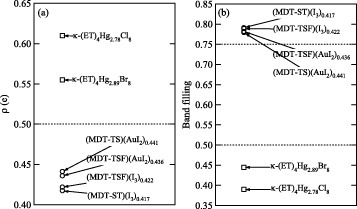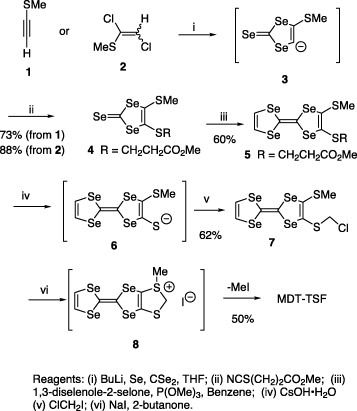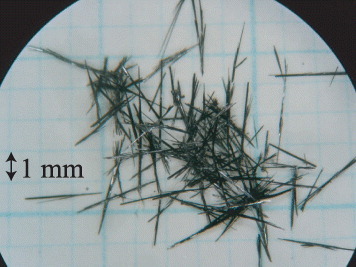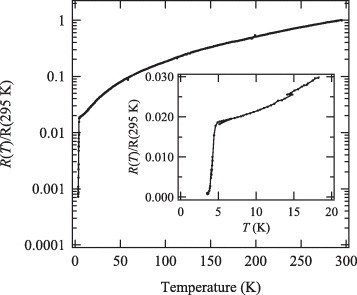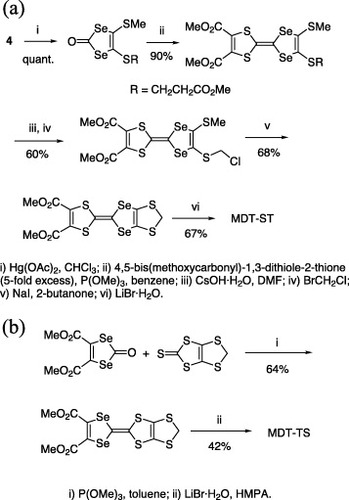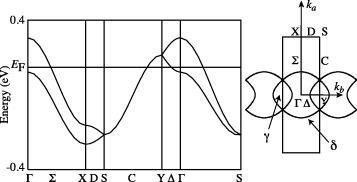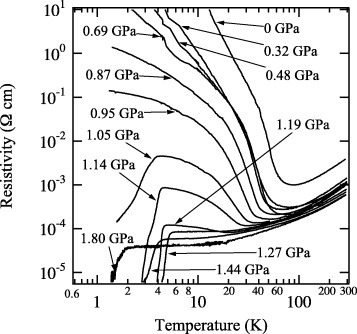Figures & data
Figure 1 (a) Chemical structure of electron donors. (b) MDT-TSF (left) and its potential precursor (right). (c) Related electron donors of MDT-TSF.
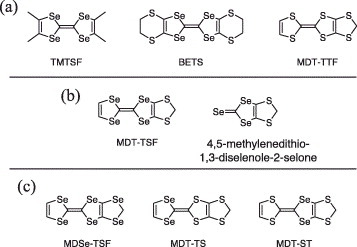
Figure 5 Temperature dependence of the magnetization of (MDT-TSF)(AuI2)0.436 at an applied field of 5 Oe. Filled circles represent zero-field-cooled (ZFC) data and open circles represent field-cooled (FC) data.
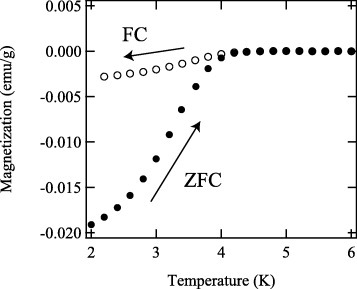
Figure 6 Temperature dependence of resistivity of trihalide salts of MDT-TSF. The materials are distinguished by the X part (I3, I2Br, IBr2 and I2.9Cl0.1) of the supporting electrolyte (n-Bu4N)X used in the electrocrystallization.
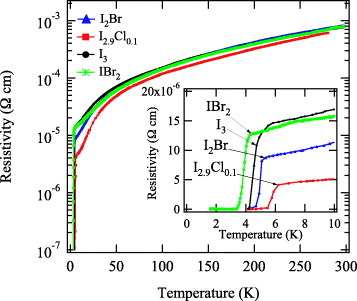
Table 1 Chemical composition, room temperature conductivity σrt, charge transfer degree ρ and superconducting transition temperature Tc of the incommensurate superconductors based on MDT-TSF and its related donors [Citation11, Citation28–34].
Figure 8 Temperature dependence of resistivity of MDT-ST salts. The materials are distinguished by the X part (I3, I2Br and I2.9Cl0.1) of the supporting electrolyte (n-Bu4N)X used in the electrocrystallization.
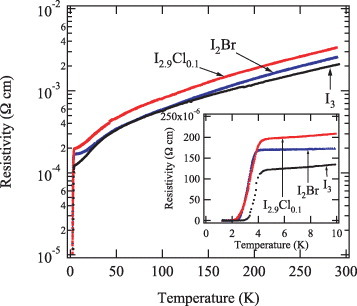
Figure 9 General molecular arrangement in the incommensurate superconductors based on MDT-TSF, MDT-ST and MDT-TS. (a) Crystal structure projected along the molecular long axis and (b) projection onto the bc plane. Note that the inter-stack interaction through the central 1,3-dichalcogenole rings is most effective.
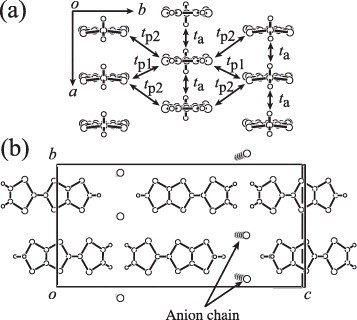
Table 2 Experimentally determined charge transfer degrees ρ, superconducting transition temperatures Tc and lattice parameters [Citation11, Citation28–33, Citation37].
Figure 10 X-ray oscillation photograph of (MDT-TSF)(AuI2)0.436 along the a∗-axis at room temperature.
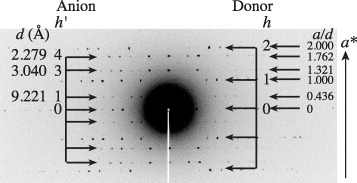
Figure 11 (a) Raman spectra of (MDT-TSF)(I3)0.422 and (b) Raman spectra of MDT-TSF salts and neutral MDT-TSF. (c) Charge-transfer degree dependence of the Raman shifts of MDT-TSF salts.
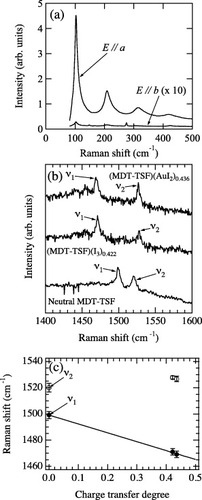
Table 3 Calculated transfer integrals and the cross-sectional area of the fundamental closed orbits, γ and δ orbits, based on the room temperature atomic coordinates [Citation32–34, Citation48].
Figure 13 (a) Magnetoresistances of (MDT-TSF)(AuI2)0.436, (MDT-TSF)(I3)0.422, and (MDT-ST)(I3)0.417. (b) Shubnikov–de Haas signals. The inset is the high field region. (c) Fast Fourier transformation spectra of the Shubnikov–de Haas oscillations of (MDT-TSF)(AuI2)0.436 in the field regions I–III defined in (b). (d) Fast Fourier transformation spectra of the Shubnikov–de Haas oscillations in (MDT-TSF)(AuI2)0.436, (MDT-TSF)(I3)0.422 and (MDT-ST)(I3)0.417.

Table 4 Shubnikov–de Haas frequencies, cross-sectional Fermi surface area ratios, effective cyclotron masses and the Dingle temperatures [Citation32, Citation47, Citation49].
Figure 14 Fermi surfaces reconstructed using q (dash-dotted lines), 2q (dashed lines), and 3q (dotted lines) of (a) (MDT-TSF)(AuI2)0.436 and (b) (MDT-ST)(I3)0.417. The original Fermi surfaces (solid lines) are also represented in both panels. The first Brillouin zone is calculated from the donor cell. The calculated closed area of the AuI2 salt is based on the room temperature atomic coordinates, and that of the I3 salt is based on 18.5 K atomic coordinates.
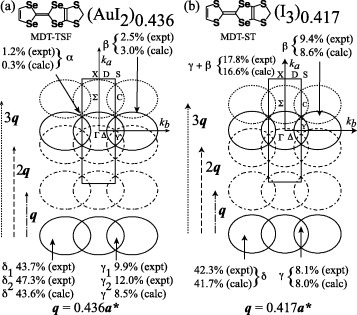
Figure 15 (a) Angular magnetoresistance oscillations of (MDT-ST)(I3)0.417. (b) p-type staggered warping Fermi surface. The magnitude of the kc-axis warping has been increased to emphasize the corrugation shape.
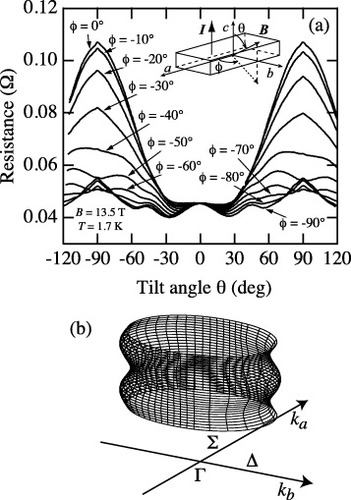
Figure 16 Temperature dependence of the (a) upper critical fields and (b) Ginzburg–Landau coherence lengths. (c) Angular dependence of the upper critical field. The solid and dotted lines represent the results of calculations based on the anisotropic 3D model and 2D model, respectively. The inset in (c) is the low-angle region. The material for all panels is (MDT-TSF)(I3)0.422.
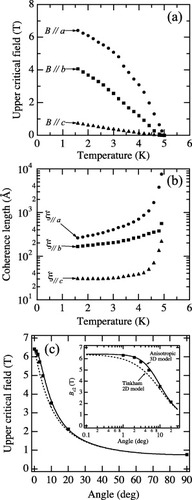
Table 5 Charge transfer degree ρ, superconducting transition temperature Tc, calculated density of states at the Fermi level N(EF), effective cyclotron mass ratio m∗/m0, calculated cyclotron mass ratio mc/m0, ratio between the effective and calculated cyclotron masses m∗/mc, and Ginzburg–Landau coherence length at 1.6 K (ξ‖a, ξ‖b, and ξ‖c) [Citation28, Citation32, Citation47, Citation49, Citation62]. The total density of states N(EF) is given in units of (total states) eV−1 (donor molecule)−1.
Figure 18 Temperature dependence of the static magnetic susceptibilities. The inset shows the data in the low-temperature region.
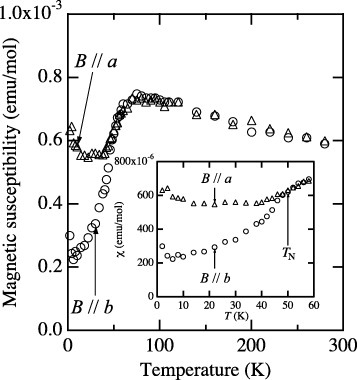
Figure 19 Magnetic torque curves of (MDT-TS)(AuI2)0.441 at 1.7 K under various magnetic field directions of θ and φ, which are the angles tilted (a) from b to c and (b) from a to c axes, respectively. The red lines in (a) are the fitted results.

Figure 20 Phase diagram of (MDT-TS)(AuI2)0.441 (PM: paramagnetic metal, AFI: antiferromagnetic insulator, SC: superconductor, CAF: canted antiferromagnetic state). The solid and dotted lines are guides for the eye.
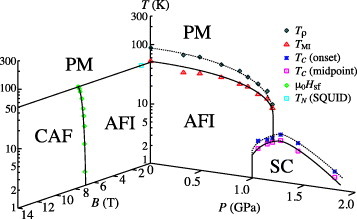
Figure 21 Model of spin arrangements for (a) β′-(ET)2ICl2 and (b) (MDT-TS)(AuI2)0.441. Dotted circles in (a) represent dimers.
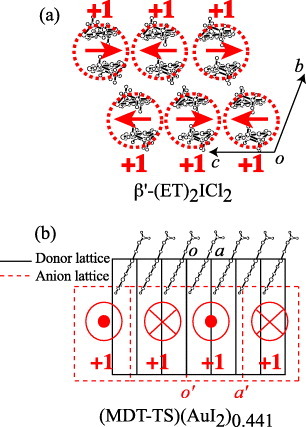
Table 6 Néel temperature TN, spin–flop field Bsf, anisotropy energy Ku, maximum midpoint superconducting transition temperature Tcmax under pressure P, energy band filling, and ground state (AFI: antiferromagnetic insulator; AF Mott: antiferromagnetic Mott insulator; IC-SDW: incommensurate spin-density-wave state; C-SDW: commensurate spin-density-wave state) for (MDT-TS)(AuI2)0.441 [Citation37], β′-(ET)2ICl2 [Citation76, Citation80], (TMTSF)2AsF6 [Citation77, Citation81], and (TMTTF)2Br [Citation82, Citation83].
Figure 22 Charge transfer degree (a) and effective energy band filling (b) of the incommensurate organic superconductors.
